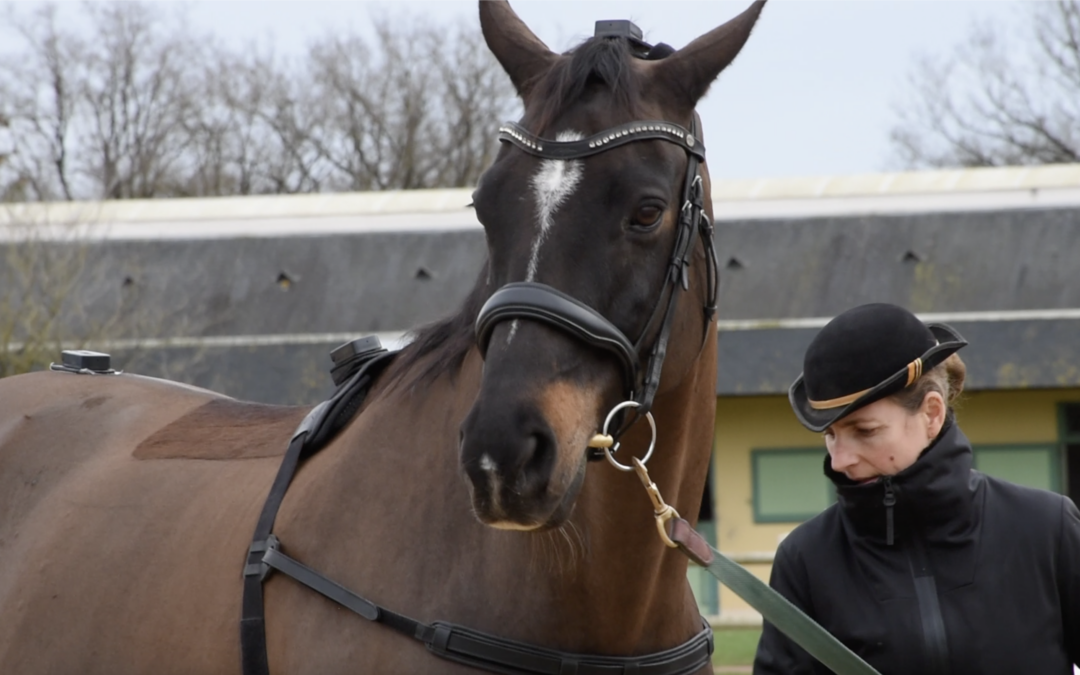Arioneo and the French Equestrian Federation have joined forces in an initiative dedicated to health, well-being and performance for equine athletes. As part of this collaboration, the Federation has made EQUISYM solutions available to the French teams.
As part of this collaboration, we were lucky enough to interview the professional dressage rider Pauline Basquin. Find out how this rider, almost in the world top 10, organizes her work with her faithful Sertorius de Rima Z*, with an approach centered on well-being and health monitoring.
Pauline Basquin, dressage rider
Can you introduce yourself please?
My name is Pauline Basquin. I’m a dressage rider at the Cadre Noir in Saumur.
Who are your horses for 2024 and what are your objectives with each one?
For this year 2024, I have ten horses in training. Ten horses divided between training horses, competition horses and horses for the Cadre Noir galas.
For competition, I have three six-year-olds, Sertorius de Rima Z* and I also have a mare who tends to do galas, but whom I’ll be taking out in competition this year.
Can you tell us more about Sertorius de Rima Z* ?
Sertorius will be fourteen this year. He arrived here at the end of his third year, and I was entrusted with riding him as soon as he arrived. I’ve been working with him for over ten years now. He’s a horse full of energy, loves to work, loves to compete and loves to show off. He is quite close to man, he’s a friendly horse.
How are you preparing for the end-of-year deadlines?
To be ready for 2024, what’s important is to really stay on the course we’ve been on up to now. We won’t get nervous, or panic because we’ve got the Olympics in our sights. We’ve always given priority to respect, harmony, fluidity and making sure that he’s happy to work.
We won’t be inventing anything new because it’s an Olympic year, but we will continue what we’ve started, the progress we’ve made over the last two or three years.
What does a typical week with Sertorius look like?
On a typical week for Sertorius, when there’s no competition, he would spend half his day in the paddock.
I try to ride him once or twice a day. So it’s not two work sessions, but one work session and one session where we either trot or I work him at a walk.
At the Cadre Noir, we’re lucky to have lots of working surfaces. So I really try to make the most of it so that he doesn’t get bored of always working in the same place.
What technological tool do you use?
I try to have an EQUISYM exam every week. It gives me a follow-up and a look at my locomotion.
I especially try to do one before and after the competition. Before to make sure that everything’s going well, and then when he gets back from the competition, to make sure that he’s had a good competition and that everything’s going well. Ideally, the vet should check up on him once a week. It’s really a follow-up on the regularity of his locomotion.
What is the veterinary follow-up for Sertorius? What do you gain from it? Does it help you guide your work?
Xavier Goupil follows Sertorius and Isabelle Burgaud in osteopathy. I’m lucky enough to have them at home.
Xavier follows him really regularly, and every time he comes back from a competition he gives him a check-up. As soon as I have a little doubt, I call him and he looks at him. It’s really important because it gives me peace of mind when I’m working, to know that my horse is doing well and not to force ourselves on something that might be developing, an injury or something else. So, having my vet here, having a lot of confidence in him, is really important for guiding my work.
What do you think of this kind of technological advance in health and performance monitoring?
I think this kind of technological advance is important, especially when you don’t have a vet on site, or someone on foot who can look at the horse. It gives us peace of mind when it comes to the horse’s physical condition and locomotion, and enables us to work on them in the best possible conditions, confident that our horse is doing well.
Do you think wellness and high performance are compatible?
For me, high level riding and well-being are compatible. This is only if you really listen to your horse, you look at him and pay attention to him.
The most important thing is really to listen to him, and of course to do everything possible to ensure his well-being. That means getting the horses out regularly, take them outside, to the paddock, let them have friends, hay at will and then all the little cares we can bring them like massages, putting them in the cold, after work, the walker, taking them outside.
As long as we listen to them and they’re doing well, there’s no reason why you couldn’t work with them at the top level.


